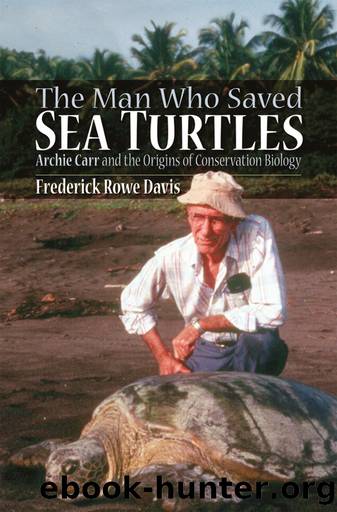The Man Who Saved Sea Turtles by Frederick Davis

Author:Frederick Davis [Davis, Frederick]
Language: eng
Format: epub
ISBN: 9780195310771
Publisher: Oxford University Press
Published: 2007-11-15T00:00:00+00:00
Africa and Florida
When Carr returned to Florida,Africa had become a part of his vision. As a naturalist and a biologist, Carr felt the influence of Africa. More than any place else, Paynes Prairie evoked Africa. The Carr family lived in a house (christened Wewa when Carr returned from Africa) to the south of Paynes Prairie, and Carr worked at the University of Florida to the north. This meant that Carr crossed Paynes Prairie thousands of times and became acquainted with its natural and cultural history.
Carr described Paynes Prairie as 50 square miles of level plain in north-central Florida, let down by collapse of the limestone bedrock. But lest anyone be left cold by that technical description, Carr clarified the significance of the place: âThe Prairie is about the best thing to see on U.S. Route 441 from the Smoky Mountains to the Keys. . . . But everybody with any sense is crazy about the Prairie.â35 Carr attempted to capture the essence of Paynes Prairie:âThe Prairie is a solid thing to hold to in a world all broken out with man. There is peace out there, and quiet to hear rails call, and the cranes bugling in the sky. It looks like Africa, out on the Prairie, looking off through the tawny plain to far bands of cattle like wildebeests in Kenya.â36
By chance one afternoon during his daily passage from one side of the prairie to the other, Carr glimpsed an event that forever linked Florida and Africa in his mind. Carr had noticed snowy egrets (Egretta thula) and buff-backed or cattle egrets (Bubulcus ibis) out on the prairie with a small herd of cows, when one of the snowy egrets began to hunt in the wake of a large, diesel dredge. In a moment of gestalt, Carr imagined that rather than a large dredge, the egret was following a large animal like those he had seen on African savanna. And this connection raised a question in his mind: why did the snowy egret, a marsh bird, leave the wetlands to follow the cowherds? After considerable rumination on the subject, it struck Carr that perhaps the snowy egret had at one time survived by following large herds of animals such as the cattle egrets of the African savanna. Carr started on this line of thinking while traveling by boat down the Lower Shire in Africa:
There where David Livingstone saw elephants, lions and buffaloes, there were only cattle for egrets to stand with. I watched them, and an idea dropped into my shifting daydream that I have not been able since to reason away. The idea was this: the snowy heron is, as the buff-back is becoming, an old game heron with the game all gone. Both of these small, white herons are today walking with cattle as a compromise with the grand living of the past, as the best they can do in a world all changed around them. The buff-back is becoming a cattle heron because the savanna fauna of Africa is being wiped outâthe snowy because the Pleistocene herds are gone.
Download
This site does not store any files on its server. We only index and link to content provided by other sites. Please contact the content providers to delete copyright contents if any and email us, we'll remove relevant links or contents immediately.
Machine Learning at Scale with H2O by Gregory Keys | David Whiting(4087)
Never by Ken Follett(3756)
Harry Potter and the Goblet Of Fire by J.K. Rowling(3756)
Unfinished: A Memoir by Priyanka Chopra Jonas(3311)
Fairy Tale by Stephen King(3192)
The Man Who Died Twice by Richard Osman(2977)
Will by Will Smith(2766)
Rationality by Steven Pinker(2269)
The Dark Hours by Michael Connelly(2210)
It Starts With Us (It Ends with Us #2) by Colleen Hoover(2171)
The Storyteller by Dave Grohl(2146)
Can't Hurt Me: Master Your Mind and Defy the Odds - Clean Edition by David Goggins(2136)
The Dawn of Everything: A New History of Humanity by David Graeber & David Wengrow(2103)
Friends, Lovers, and the Big Terrible Thing by Matthew Perry(2096)
The Becoming by Nora Roberts(2056)
The Stranger in the Lifeboat by Mitch Albom(2029)
Cloud Cuckoo Land by Anthony Doerr(2011)
Einstein: His Life and Universe by Walter Isaacson(1944)
Love on the Brain by Ali Hazelwood(1931)
